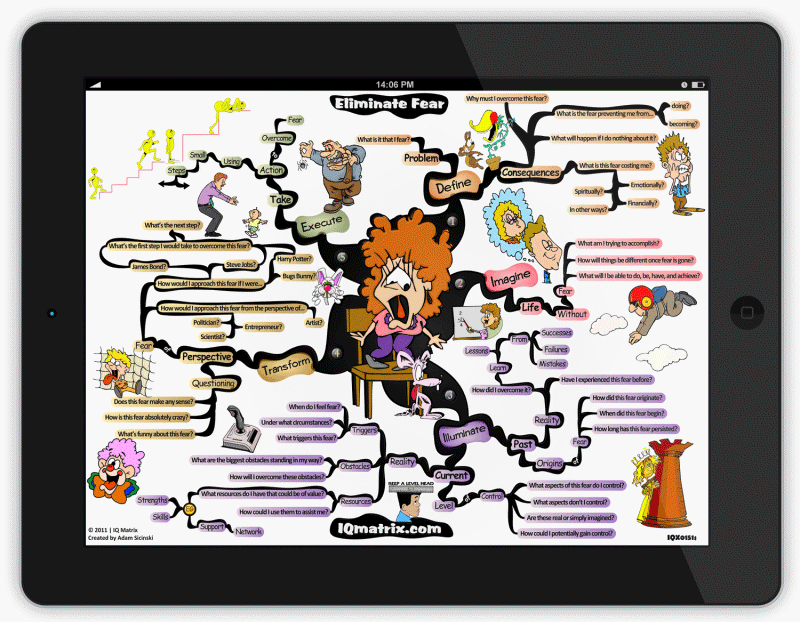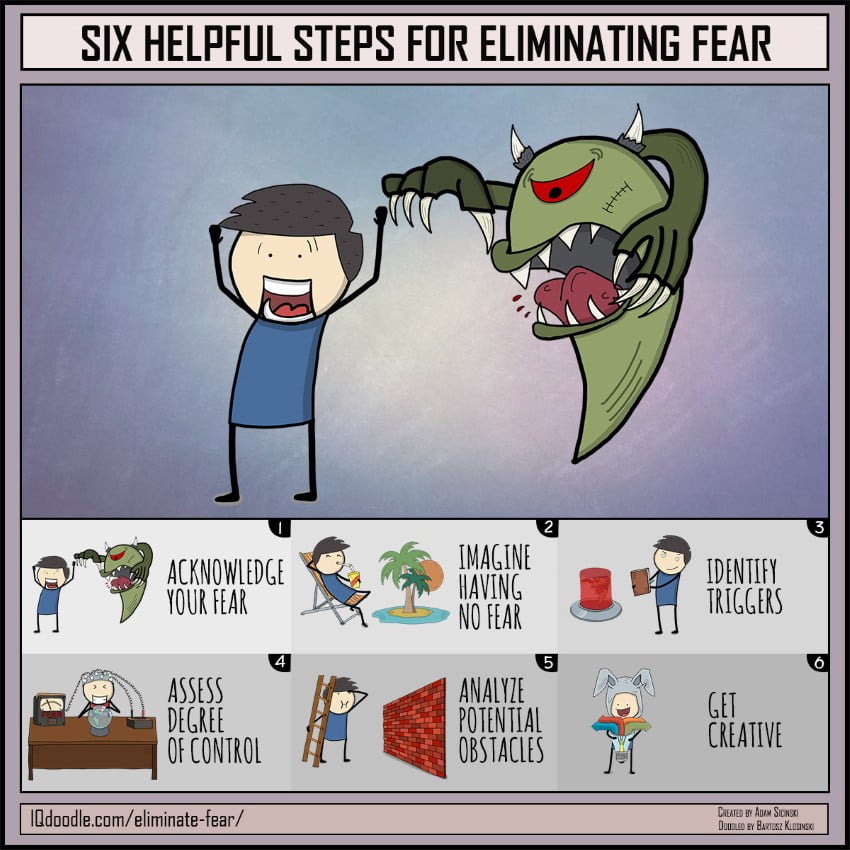The greatest mistake we make is living in constant fear that we will make one. – John Maxwell
Taking Control of Your Fears
It’s probably safe to say that we all experience fear of some kind throughout our lives. This fear often results from a level of uncertainty that we have about something. Moreover, it prevents us from taking the necessary actions we want to take in order to achieve a desired outcome. This consequently can diminish our levels of self-esteem, and can, therefore, hold us back from taking the necessary actions in other areas of our lives.
In many ways, it seems that if we are unable to effectively manage and overcome a fear that we tend to experience in particular situations, that this fear will likely spread like a virus into other areas of our lives and cripple us emotionally in many more — and sometimes unforeseen — ways.
Fears rob us of our self-esteem, self-confidence, and self-belief. The more we indulge in them, the deeper we plunge into the abyss of emotional turmoil and the paralysis of inaction, which can affect all areas of our lives.
Even though on the surface fears seem unhealthy, they do however serve us by revealing that we are in fact lacking in experience, knowledge, and understanding.
Within this article, I will take you through a five-step process that you can use at any time to help you overcome the fears you experience on a daily basis. All you need to do is simply work through these steps in the sequence provided to progressively eliminate your fear. Keep in mind though, that you may need to move through this fear elimination process several times in order to gain maximum value. Let me quickly explain how this is relevant.
Dig Deep by Asking Questions
When we ask a question such as: “Why am I feeling afraid?” we initially get a surface response. The first answer we receive will give us a glimpse into the reasons behind the fear, however, this may not be the real reason why we are afraid. As such we need to dig deeper by asking the question again, again and again. Only once the question has been asked several times will we start unveiling the real reasons why we’re afraid.
The same applies to this fear elimination process. The more you use it, the deeper insights you will gain, and the more likely you will be able to eliminate the hold that your fear has over your life.
The Five-Step Process for How to Eliminate Fear
Here is an outline of the five-step process we will work through today to help you overcome your fear:
- Define your problem/fear and the consequences.
- Imagine life without this fear.
- Illuminate your past and current reality.
- Transform your perspective and understanding of your fear.
- Execute by taking action to overcome your fear.
Before going through these steps, it might be helpful to read how to overcome fear article I previously posted on the blog. This article will give you more information about your fears while providing you with some tips and strategies to help you overcome them.
Below I break down each of the five fear elimination steps in a little more detail. As you work your way through this process, it might be helpful to print the mind map at the top of this page and use it as a reference poster to help guide along this journey.
Step 1: Define
The most important step is always the first step. You must first know and understand what it is that you fear. If you are not specific and clear here, then you will struggle to gain traction with the remaining steps of the fear elimination process. Therefore, to begin with, ask yourself:
What is it that I fear?
As mentioned in the previous section, don’t just ask this question once, instead ask it several times. What might be clear on the surface might not be the real fear that’s hiding under the exterior. You may, therefore, like to pose a different question:
What problem am I facing?
What is the real problem I am dealing with here?
Once you are clear about your fear, you must now get a better understanding of the consequences you are experiencing resulting from this problem. Ask yourself:
What is the fear preventing me from doing?
What is the fear preventing me from becoming?
What will happen if I do nothing about it?
What is the fear costing me emotionally, spiritually, financially, and in other ways?
The reason we ask these questions is to create emotional pain. The pain is designed to provide you with enough leverage to force you to make a change. In fact, the more pain you are able to generate at this stage, the more motivation you will have to turn your fear into a passion for change and a desire to take positive action.
Finally, at this stage you may also want to ask yourself one other question:
Why must I overcome this fear?
Think of as many reasons as you can as to why you must overcome this fear today. The more legitimate reasons you come up with, the more emotional leverage you will gain to take the desired actions to eliminate your fear. However, yet again, don’t just ask the question once, but rather ask it many times. This is important because each time you ask this question you will get a slightly different answer. And the more answers you have, the more emotional leverage you will build.
Once you have built enough emotional leverage, you are ready to move onto the next stage.
Step 2: Imagine
Having defined your problem and identified the consequences, it’s now time to imagine a life without this fear. Take time now to ask yourself:
What am I trying to accomplish?
How will things be different once this fear is gone?
What will I be able to do, be, have and achieve?
What is important here is that you gain clarity on what it is exactly that you would like to accomplish.
It’s all well-and-good to want to overcome a fear, but in the end, you want to overcome this fear because you have a desire to achieve or accomplish a specific goal. Well, if that’s the case, then you must be very clear about what it is you would like to accomplish.
At this stage, it’s also important to let your mind run-free and imagine how extraordinary your life will be without this fear. You can do this through the process of visualization, or simply by writing out your desired reality on a sheet of paper.
Within the previous stage, you were building a pushing-force that pushed you away from the negative consequences of your fear. What you are doing at this stage is building a pulling-force — something that will pull you towards your desired outcome. Both these forces are necessary to build the leverage you need to help you overcome your fear.
Step 3: Illuminate
Now, that you have enough leverage behind you to push and pull you towards your desired outcome, let’s now take a closer look at your past and current reality — this will help you to get a better understanding of your fear and how it took form.
Origin of Fear
Let’s first take a look at the origins of your fear by asking the following questions:
How did this fear originate?
When did this fear begin?
How long has this fear persisted?
These questions are important because they help you to illuminate when and where this fear cropped up in your life.
Being clear here may help you gain better insights, solutions, and ideas that will assist with eliminating your fear within the later stages of the fear elimination process.
Past Experience
It’s very likely that you have probably experienced this fear before. If this is true, then ask yourself the following questions:
Have I experienced this fear before?
How did I overcome the fear?
How did I fail to overcome my fear?
It’s important to learn the lessons from your past that will help you better manage your fear in the present moment. To do this think about your successes, failures, and mistakes. Think about how you approached this fear in the past, and consider what worked or didn’t work for you. The answers to these questions will provide you with valuable insights that will help you to tackle your fear in the present moment.
Now that you understand your past reality, let’s now take a look at your current reality as it relates to the fear or problem you are experiencing.
Fear Triggers
The first thing we want to look at are your triggers. Triggers are the things that set-off your fear. These triggers could be people, things, words, experiences, a particular situation, etc.
To unlock triggers, ask yourself the following questions:
When do I feel this fear?
Under what circumstances?
What specifically triggers this fear in me?
Once you are clear about what it is that sets-off your fear, it’s now time to look at how much control you have over your fears.
Level of Control
It’s important to identify how much of the circumstances surrounding the fear we actually control. At times this might be significant, while at other times we might find that we have very little control. Either way, it’s important to become clear by separating real from the imagined circumstances. Ask yourself:
What aspects of this fear do I control?
What aspects don’t I control?
Are these real or simply imagined?
How could I potentially gain control over these things?
The more control you have over aspects of your fear and the circumstances surrounding your fear, the more confidence you will gain, and the more likely you are to eliminate your fear during the next stage of the fear elimination process. Also keep in mind that when it comes down to it, what you control is your response to events and circumstances (triggers). And this is where change always begins — within your own psyche.
Identify Obstacles
Considering now that you understand how much control you have over your fear, let’s now take a look at the obstacles that could stand in your way as you work towards overcoming this fear. Ask yourself:
What are the biggest obstacles standing in my way?
How will I overcome these obstacles?
Many times our fears overwhelm us because we fail to plan ahead for potential challenges. These obstacles breed uncertainty and cause us to doubt ourselves and our own abilities. Therefore, the more clarity you have about possible obstacles that you may come across along this journey, the more likely you are to succeed in eliminating whatever it is that you fear.
Identify Resources
Finally, having clarified your triggers, levels of control and obstacles, it’s now important to identify the resources you have on hand that may help you to overcome the obstacles you will face along this journey. Ask yourself:
What resources do I have that could be of value here?
How could I use them to assist me?
Your resources may include your strengths, skills, tools, support network, etc. Use your resource list as a support mechanism to help you eliminate the fear you are experiencing.
Step 4: Transform
We now come to the best part of the fear elimination process. In my mind, it’s the best part because this is where the fun begins, where we begin shifting our perspective and understanding of our fears in creative ways.
The purpose of the transformation stage is to open your mind to possibilities that you may never have considered before. It’s all about expanding your creative capacity and pushing the boundaries of what you believed was possible.
Many times, we experience fears because we have a set of limiting beliefs clinging to each of these fears. These limiting beliefs create resistance and prevent us from moving forward.
One of the best ways to overcome these limiting beliefs is to ask questions that will help you to challenge the fears you are experiencing. Ask yourself:
Does this fear make any sense?
How is this fear absolutely crazy and absurd?
As a matter a fact, what is funny about this fear that I hadn’t realized before?
Keep asking these questions over and over again to help weaken the beliefs that are supporting your fear. The more answers you are able to generate, the more likely you are to loosen the grip that your fear has on your life.
Another way to shift your perspective and transform your understanding of your fear is to utilize lenses. This basically involves putting yourself into someone (or something) else’s shoes and developing a plan of action to overcome the fear from their perspective.
For instance, take your fear and ask yourself the following set of questions:
How would I approach this fear from the perspective of an artist? Politician? Entrepreneur? Scientist?
How would I approach this fear if I were Bugs Bunny? Harry Potter? James Bond? Steve Jobs? Richard Branson?
What’s the first step I would take to overcome this fear?
What’s the next step I would take?
By consciously taking time to use these lenses to shift your perspective and understanding of how to overcome your fear, you effectively free your mind from the constraints of its own limited thinking processes. As a result, you will be able to think more broadly without any limitations. Moreover, any limiting beliefs that may still be holding you back, will be released and will become insignificant while you’re working through each of these lenses.
In the end, it’s critical that you build a solid plan of action to move you towards your desired outcome by using one or more of these lenses. If anything, they will help you to expand your understanding of what’s possible if you commit 100% to your desired outcome.
Step 5: Execute
The final stage of the fear elimination process is to take action. However, early on, it’s important you do this using small steps, otherwise, you risk pulling yourself back into your comfort zone.
Likewise, it’s important to understand that success with anything isn’t a straight path. It may, in fact, take several attempts, and you may often veer off course. However, as long as you stay committed to the outcome you desire to have in your life, and you have enough leverage behind you to move you to take the necessary action, then sooner or later — as long as you keep moving forward — you will eliminate your fear and experience the life you desire to live.
Concluding Thoughts
There is no doubt that you will make mistakes along the way, you’re human after all. Mistakes are there to be made. As long as you learn from them, adapt and keep moving forward, you will eventually get to your desired destination.
John Maxwell once said that:
The greatest mistake we make is living in constant fear that we will make one.
Eliminating fear from your life is possible the moment you let go of the fear of making a mistake. To do this you must understand that life is a journey of self-discovery, of new experiences and of uncertainty. The uncertainty you experience is what makes life fun, exciting and exhilarating. It’s what living is all about, and it’s the reason why our fears are not to be avoided, but rather to be understood and acted upon.
Time to Assimilate these Concepts
Did you gain value from this article? Is it important that you know and understand this topic? Would you like to optimize how you think about this topic? Would you like a method for applying these ideas to your life?
If you answered yes to any of these questions, then I’m confident you will gain tremendous value from using the accompanying IQ Matrix for coaching or self-coaching purposes. This mind map provides you with a quick visual overview of the article you just read. The branches, interlinking ideas, and images model how the brain thinks and processes information. It’s kind of like implanting a thought into your brain – an upgrade of sorts that optimizes how you think about these concepts and ideas. 🙂
Recommended IQ Matrix Bundles
If you’re intrigued by the idea of using mind maps for self-improvement then I would like to invite you to become an IQ Matrix Member.
If you’re new to mind mapping or just want to check things out, then register for the Free 12 Month Membership Program. There you will gain access to over 90 mind maps, visual tools, and resources valued at over $500.
If, on the other hand, you want access to an ever-growing library of 100s of visual tools and resources, then check out our Premium Membership Packages. These packages provide you with the ultimate visual reference library for all your personal development needs.






